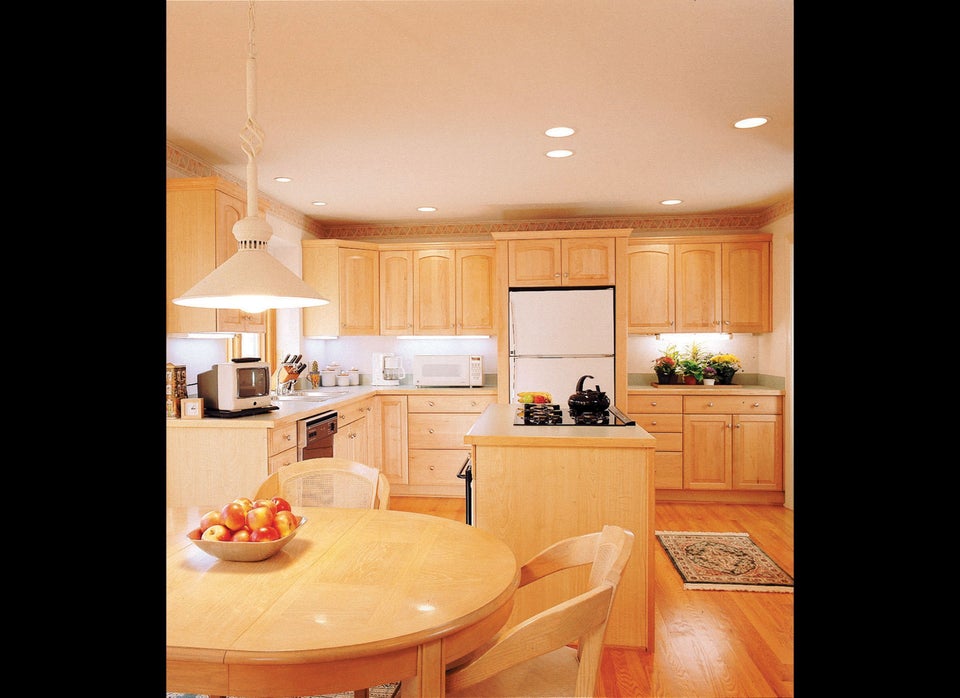Walk into any hardware store and you're presented with rows full of lighting options. Incandescent or fluorescent? 40 watt or 100 watt? Yellow light or blue light? Somehow, over the past few years, that visit to the local store for a new lightbulb has turned from an easy five minute job to a frustrating event. But, we say enough! Choosing a lightbulb doesn't have to be this hard, so we've put together an all-encompassing guide to make sure you've got the right lights for every area in your home.
Let's start with the basics: incandescent, fluorescent or LED? Each type of bulb has its own benefits and limits, and choosing which style to use in your home is really a matter of personal preference.
- Incandescent lights are ones that glow as a result of an electric current heating a metal filament. They're inexpensive and have a great light quality (that's warm to compliment skin tones), but they burn-out fast as a result of the heat and are being phased out of stores--even though the government-mandated incandescent light ban was overturned in December. They can also be used easily with dimmer switches and have a wide variety of colors. Our favorites are amber (which creates a glow reminiscent of a fire or open flame), light blue (which filter out the yellow to make a very crisp white light) and pink (which compliment natural skins tines beautifully).
For more information about differences between these bulbs, check out this New York Times article. To learn more about different types of bulbs (from reflector to globes and everything in between), take a look at this buying guide. And, if you're thinking about investing in dimmers, here are great DIY instructions.
Phew, now that that's over, let's move onto wattage. Watts are the standard unit for measuring electricity. For lighting, there are three basic levels - mood lighting (about 40 watts), task lighting (about 100 watts) and the in-between or average lighting (often 60-75 watts). Most packages will only gives these incandescent numbers, but to calculate the equivalent fluorescent or LED wattage, just divide the incandescent wattage by four. So, if you are looking for mood lighting which is 40 watts on an incandescent bulb, look for 10 watt LEDs.
While this information is great, we've all heard the mood vs. task lighting tip before, so we want to look at things a little more closely. What watts should you use in an overhead light? What about in a porch light? We reached out to GE Lighting Institute Manager Mary Beth Gotti for helpful tips, so keep reading for the breakdown.
- Overhead Light In The Hall Keep hallways brightly lit because they get little to no natural light. We suggest two or three 50 watt bulbs if there are multiple fixtures or a single fixture with multiple bulbs. For a single bulb fixture, try 80-100 watts.
- Porch Light Mary Beth suggest "halogen lights in the 20 watt range should be perfect for a pathway" so you're not being blinded on the walk to your house. However, "for carriage lights or lanterns [on the porch], bump that up to 40 or 60 watts."
- Recessed Lights Keep recessed lights around 60 watts to prevent from turning them into spotlights.
- Nightstand Lights 50-60 watts is best for nighttime tasks like reading a book or reviewing notes. But, to keep from that seeming too bright in an otherwise dim room, make sure your lamp shade shields the bulb from your direct eye sight.
- Desk Lights When working at your desk, you want to make sure you don't strain your eyes and the best way to do this is to find a desk light at about the same wattage as your computer screen. For a room with decent natural light, that should be around 60 watts. For a room with few/no windows, balance the 60 watt desk light with ambient overhead lights or bump that number up to 75 watts.
- 'Boob' Lamps This typical ceiling lamps (featuring a domed shade) often have more opaque covers, so we suggest using a 75 watt light.
- Kitchen Kitchen lights should be bright because you are working with knives and other cooking materials. For dark kitchens and more opaque fixtures, try 100 watts. If you get a lot of natural light, try using a slightly dimmer 80 watt bulb.
- Bathroom Sconces Keep bathroom sconces around 60-80 watts (But, this can be split. So two 40 watt bulbs in a pair of sconces or three 30 watt bulbs above the mirror for example). Pink lights will help compliment your skin tone, but Mary Beth also reminded us that "makeup looks different in different lights. Going out for an evening event where the light is subdued will be a warmer environment, whereas going to the office is a cooler tone." So, if you do opt for a warm-colored bulb, remember your makeup will look a little different when your in the office.
- Dining Room Chandelier For the best results, keep the total wattage of dining room chandelier between 200-400 watts depending on the room size. So, this can mean two 100 watt bulbs, four 60 or 75 watt bulbs, eight 50 watt bulbs and so on.
In general, you can multiply the square footage of a room by 1.5 to figure out the total amount of wattage needed to properly light the space. For task lighting, you can bump that multiplier to 2.5. And, remember to always check the fixture to see what the maximum wattage allowed is since exceeding that number can be very dangerous.
Want some more info? Check out these additional expert lighting tips and flip through the slideshow below for some great overall lighting suggestions for each room in your home!
All Photos Courtesy of GE Lighting
